Name: Hickory, Mockernut
Botanical Name: Carya tomentosa
Form: Tree
Parts Used: Nuts, browse
Citation: Guenther, K. (2021, January 1) Hickory as wildlife food [Web log post.] Retrieved: supply the date, from http://wildfoods4wildlife.com
Getting Started
Hickory is a pantry staple of many critters, and hopefully is or will become a rehab staple you lay in store. Along with walnuts— to which they are related— hickory nuts are shelf-stable and easy to store without spoilage, especially compared to the fussy acorn. Mature hickories are pretty reliable producers year after year. Though the different species of nuts have differences in appearance, the nuts are generally easily recognizable and can be gathered readily by volunteers.
Juglandaceae (Walnut Family)
Carya (Hickory Genus)

| Common name | Virginia Carya species | Origin | Rare Plant Status |
| Water hickory | C. aquatica | native | Yes, in some states (not Virginia) |
| Southern shagbark hickory | C. carolinae-septentrionalis | native | Globally secure, but critically imperiled in Virginia. |
| Bitternut hickory | C. cordiformis | native | Yes, in some states (not Virginia) |
| Pignut hickory | C. glabra | native | Not rare |
| Pecan | C. illinoinensis | native | Not rare |
| Shellbark hickory | C. laciniosa | native | Yes, in some states (not Virginia) |
| Red hickory | C. ovalis | native | Not rare |
| Shagbark hickory | C. ovata | native | Not rare |
| Sand hickory | C. pallida | native | Not rare |
| Mockernut hickory | C. tomentosa | native | Not rare |

Virginia Botanical Associates. (Accessed December 2020). Digital Atlas of the Virginia Flora (http://www.vaplantatlas.org). c/o Virginia Botanical Associates, Blacksburg.
USDA, NRCS. 2015. The PLANTS Database (http://plants.usda.gov, 26 December 2020). National Plant Data Team, Greensboro, NC 27401-4901 USA.
About this Species: In this document, I will include photos of a number of different hickory species, though I have chosen mockernut to highlight.

Key Features to look for: In addition to the identification guide of your choice, here are a couple of features you should see on mockernut hickory:
- The leaf consists of seven to nine finely-toothed leaflets
- Leaf undersides and twigs are wooly
- Mockernuts in the husks are about the size of a golf ball. The very thick husks easily open into four sections when mature
- The following are some online additional identification infographics:
- https://m.wikihow.com/Identify-Hickory-Nuts
- https://m.wikihow.com/Identify-Hickory-Trees
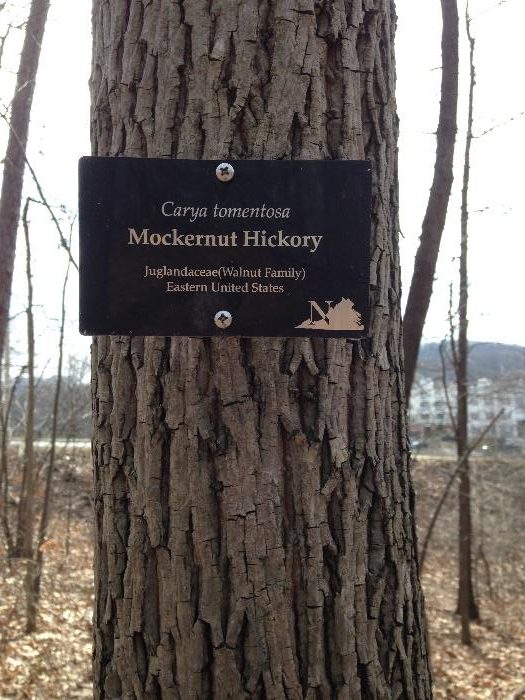
Flower Description: The flowers you are most likely to notice on hickory are the male catkins, which look a little like dangling groups of three-inch-long pipe cleaners. The female flowers are on the same tree (monoecious) but are hard to see. The female ovary develops into the nut.

Leaf Description: One leaf consists of seven to nine finely-toothed leaflets. The undersides of the leaves are wooly and orangish in color, and the leaflet tips are pointed. The leaves are pinnate which means they are arranged like a feather. The largest leaflet is at the tip. Different species of hickories have varying numbers of leaflets that make up a leaf. The leaves of hickory turn bright schoolbus yellow in the fall and are aromatic when you crush them.

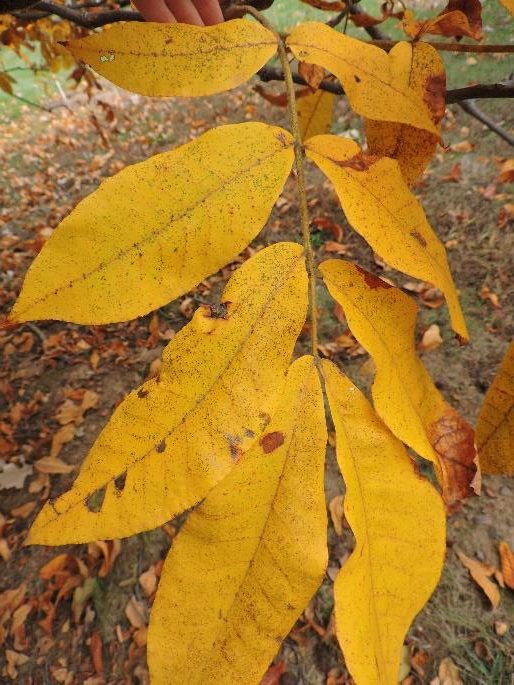

Nut Size: Mockernut nuts in the husk are about two inches diameter round, golf ball size. The husk is very thick and easily breaks into four sections to release the nut. The nutmeats are inside the hard hull of the marble-sized nut.

Harvest
| Jan | Feb | Mar | Apr | May | Jun | Jul | Aug | Sep | Oct | Nov | Dec | ||||||||||||||
|---|---|---|---|---|---|---|---|---|---|---|---|---|---|---|---|---|---|---|---|---|---|---|---|---|---|
| winter | winter | late winter | early spring | spring | late spring | early summer | summer | late summer | early fall | fall | late fall | ||||||||||||||
| nuts | x | x | x | ||||||||||||||||||||||
Is this a good enrichment item? Nuts are almost always good enrichment items because you can control how much work you want your patient to do to reach the reward. Hickory nuts can be offered fully in the husk, or you can remove the husk and just offer the nuts in the hull. You can even pre-crack the nut hulls (shells) prior to offering them to younger or weaker patients.
When to Harvest Hickory Nuts: Hickory nuts are mature and ready to harvest when they fall off the tree.
How to Store Hickory Nuts: When storing nuts of any kind, if you can easily remove the husks before storage, you should do so as it will save space and reduce the moisture content and thus reduce molding. It’s easy to remove the husks of mockernut with your fingers. You can read about a variety of experiments of different storage methods for a variety of nuts including mockernut here: https://wildfoods4wildlife.com/harvesting-cleaning-storage/storing-nuts/
From that experiment, I determined the best way to store hickory nuts is the following:
- remove the outer husk
- air dry the nuts for several weeks indoors
- store the nuts in their hulls indoors at room temperature where they have access to air (not an airtight container) but have protection from rodents. Mesh bags – like onion bags—can be hung and work well
How to Harvest Hickory Browse:
Browse as a term used on this website refers to the twigs and small branches, with or without leaves or needles, of trees, shrubs, vines and other woody-stemmed plants. Browse can also refer to bark, for the animals that gnaw on bark.
Small trees cannot tolerate very much cutting and survive. The best time to harvest browse for the health of the tree is late fall to winter, but that may not be when you need the browse. The best limbs to remove are ones that rub together and cause abrasions that can make the tree vulnerable to insect damage. Or, cut branches that are overcrowded or hang low to the ground. Prune branches back to the base where the branch meets the trunk to minimize future insect damage to the tree.
Dip pruning shears into a bleach-water solution (1:3) to minimize transferring tree diseases from one tree to the next.
Place the cut end of the browse in a bucket of water as soon as possible after cutting— ideally taking a bucket of water with you as you harvest because the branch will start to close itself off the instant it is injured. Then keep them in water as much as possible prior to feeding, which ideally means even during transport. Keep the bucket of browse in the shade.
Browse cuttings are best fed to animals right away. They do not store well for more than a day before the leaves start to wilt and dry out, especially if it is hot.
Some Other Hickory Species
Photo thanks to Don and Barb Plants of New Market, VA.
Shagbark Hickory
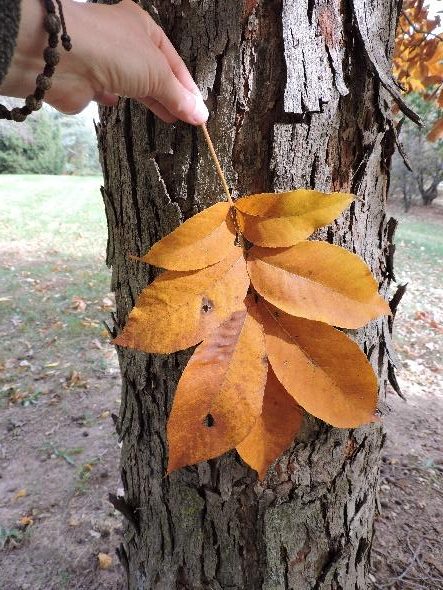
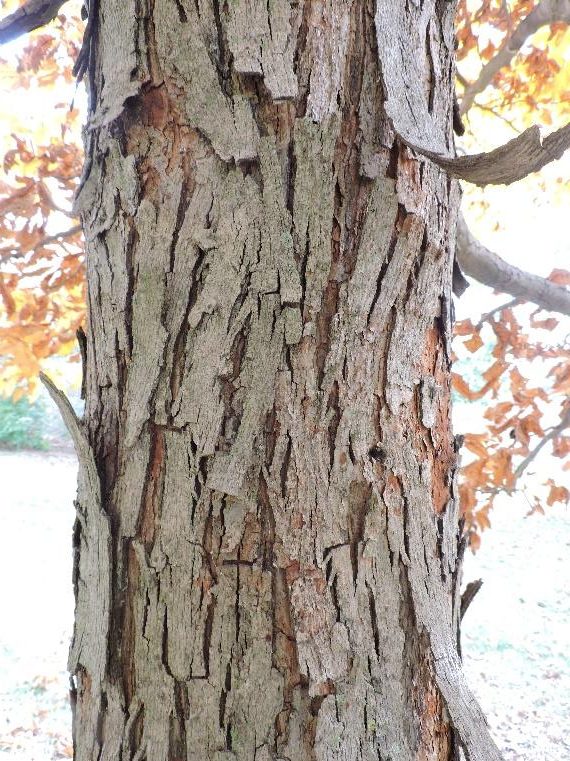
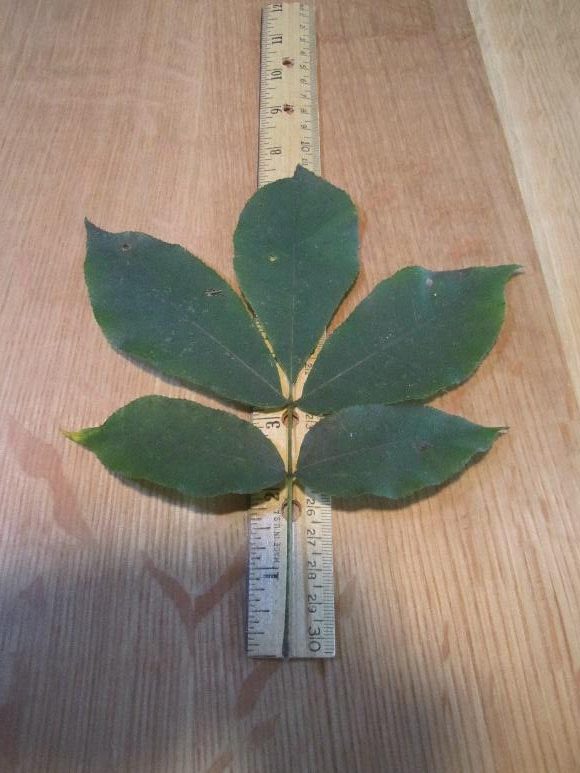


Bitternut Hickory
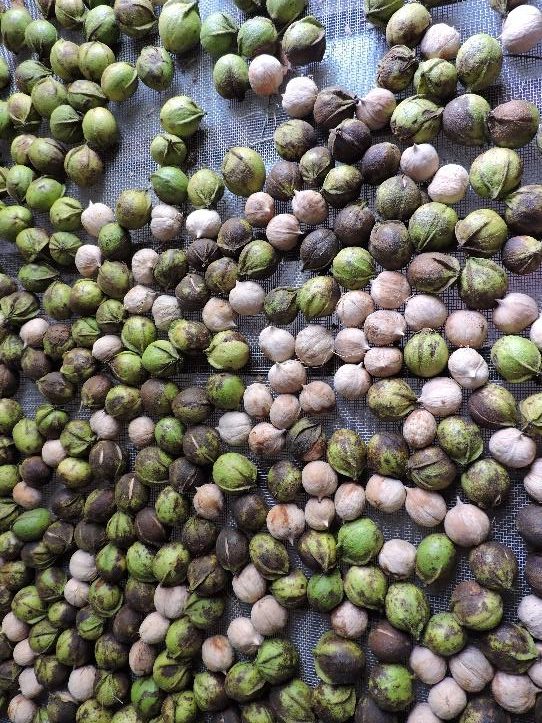


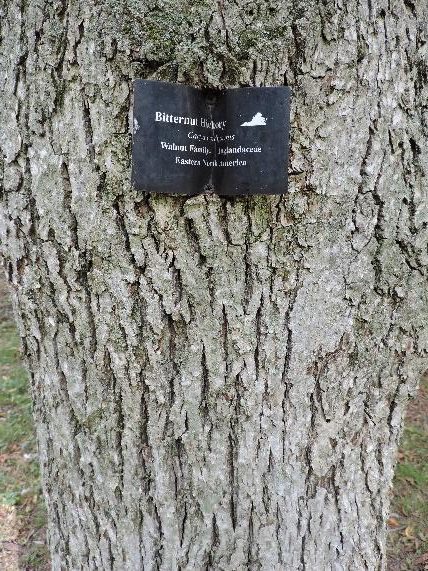
Rare Hickory Species in Virginia
| County in Virginia | Species | Alert |
| Halifax Co. | Southern shagbark hickory | globally secure, critically imperiled in Virginia. |
Feed Hazel to:
hickory | (Carya spp.) | browse/bark |
|---|---|---|
Bear, American Black | Ursus americanus |
|
Beaver, American | Castor canadensis |
|
Cottontail, Eastern | Sylvilagus floridanus |
|
Deer, White-tailed | Odocoileus virginianus |
|
Fox, Eastern Gray | Urocyon cinereoargenteus |
|
Mouse, Common White-footed | Peromyscus leucopus |
|
hickory | (Carya spp.) | nuts |
Bear, American Black | Ursus americanus |
|
Beaver, American | Castor canadensis |
|
Chipmunk, Eastern | Tamias striatus |
|
Cottontail, Eastern | Sylvilagus floridanus |
|
Deer, White-tailed | Odocoileus virginianus |
|
Flying Squirrel, Southern | Glaucomys volans volans |
|
Fox, Eastern Gray | Urocyon cinereoargenteus |
|
Fox, Red | Vulpes vulpes |
|
Mouse, Common White-footed | Peromyscus leucopus |
|
Opossum, Virginia | Didelphis virginiana |
|
Raccoon, Northern | Procyon lotor |
|
Squirrel, American Red | Tamiasciurus hudsonicus |
|
Squirrel, Eastern Fox | Sciurus niger |
|
Squirrel, Eastern Gray | Sciurus carolinensis |
|
Bunting, Indigo | Passerina cyanea |
|
Cardinal, Northern | Cardinalis cardinalis |
|
Crow, American | Corvus brachyrhynchos |
|
Jay, Blue | Cyanocitta cristata |
|
Nuthatch, White-breasted | Sitta carolinensis |
|
Sapsucker, Yellow-bellied | Sphyrapicus varius |
|
Sparrow, Field | Spizella pusilla |
|
Titmouse, Tufted | Baeolophus bicolor |
|
Towhee, Eastern | Pipilo erythrophthalmus |
|
Bobwhite, Northern | Colinus virginianus |
|
Duck, Wood | Aix sponsa |
|
Mallard | Anas platyrhynchos |
|
Pheasant, Ring-necked | Phasianus colchicus |
|
Turkey, Wild | Meleagris gallopavo |
|
hickory, bitternut | (Carya cordiformis) | browse/bark |
Beaver, American | Castor canadensis |
|
Cottontail, Eastern | Sylvilagus floridanus |
|
hickory, mockernut | (Carya alba) | browse/bark |
Deer, White-tailed | Odocoileus virginianus |
|
Mouse, Common White-footed | Peromyscus leucopus |
|
hickory, mockernut | (Carya alba) | nuts |
Bear, American Black | Ursus americanus |
|
Beaver, American | Castor canadensis |
|
Deer, White-tailed | Odocoileus virginianus |
|
Fox, Eastern Gray | Urocyon cinereoargenteus |
|
Fox, Red | Vulpes vulpes |
|
Mouse, Common White-footed | Peromyscus leucopus |
|
Squirrel, American Red | Tamiasciurus hudsonicus |
|
Squirrel, Eastern Fox | Sciurus niger |
|
Squirrel, Eastern Gray | Sciurus carolinensis |
|
hickory, pignut | (Carya glabra) | browse/bark |
Deer, White-tailed | Odocoileus virginianus |
|
hickory, pignut | (Carya glabra) | nuts |
Bear, American Black | Ursus americanus |
|
Chipmunk, Eastern | Tamias striatus |
|
Cottontail, Eastern | Sylvilagus floridanus |
|
Fox, Eastern Gray | Urocyon cinereoargenteus |
|
Fox, Red | Vulpes vulpes |
|
Raccoon, Northern | Procyon lotor |
|
Squirrel, American Red | Tamiasciurus hudsonicus |
|
Squirrel, Eastern Fox | Sciurus niger |
|
Squirrel, Eastern Gray | Sciurus carolinensis |
|
Crow, American | Corvus brachyrhynchos |
|
Jay, Blue | Cyanocitta cristata |
|
Nuthatch, White-breasted | Sitta carolinensis |
|
Sapsucker, Yellow-bellied | Sphyrapicus varius |
|
Bobwhite, Northern | Colinus virginianus |
|
Duck, Wood | Aix sponsa |
|
Pheasant, Ring-necked | Phasianus colchicus |
|
Turkey, Wild | Meleagris gallopavo |
|
hickory, shagbark | (Carya ovata) | nuts |
Bear, American Black | Ursus americanus | strong preference |
Chipmunk, Eastern | Tamias striatus | strong preference |
Squirrel, Eastern Fox | Sciurus niger | strong preference |
Cottontail, Eastern | Sylvilagus floridanus |
|
Fox, Eastern Gray | Urocyon cinereoargenteus |
|
Fox, Red | Vulpes vulpes |
|
Mouse, Common White-footed | Peromyscus leucopus |
|
Squirrel, American Red | Tamiasciurus hudsonicus |
|
Squirrel, Eastern Gray | Sciurus carolinensis |
|
Crow, American | Corvus brachyrhynchos |
|
Jay, Blue | Cyanocitta cristata |
|
Nuthatch, White-breasted | Sitta carolinensis |
|
Sapsucker, Yellow-bellied | Sphyrapicus varius |
|
Bobwhite, Northern | Colinus virginianus |
|
Duck, Wood | Aix sponsa |
|
Mallard | Anas platyrhynchos |
|
Pheasant, Ring-necked | Phasianus colchicus |
|
Turkey, Wild | Meleagris gallopavo |
|
pecan | (Carya illinoinensis) | browse/bark |
Deer, White-tailed | Odocoileus virginianus |
|
pecan | (Carya illinoinensis) | nuts |
Opossum, Virginia | Didelphis virginiana |
|
Raccoon, Northern | Procyon lotor |
|
Squirrel, Eastern Fox | Sciurus niger |
|
Squirrel, Eastern Gray | Sciurus carolinensis |
|
Bunting, Indigo | Passerina cyanea |
|
Book & Journal References:
Fontentot, W.R. (2017). Avian Frugivory in Louisiana. Journal of Louisiana Ornithology. Vol. 10, pp. 11-40.
Martin, A.C., Zim, H.S., Nelson, A.L. (1951). American Wildlife and Plants: A Guide to Wildlife Food Habits. New York: Dover Publications.
Scott, M. (2013). Songbird Diet Index. National Wildlife Rehabilitators Association, St. Cloud, MN.
Townsend, J. F. (2019, March). Natural Heritage Resources of Virginia: Rare Plants. Natural Heritage Technical Report 19-15. Virginia Department of Conservation and Recreation, Division of Natural Heritage, Richmond, Virginia. Unpublished report.
Online References:
USDA, NRCS. 2015. The PLANTS Database (http://plants.usda.gov, 26 December 2020). National Plant Data Team, Greensboro, NC 27401-4901 USA.
Virginia Botanical Associates. (Accessed December 2020). Digital Atlas of the Virginia Flora (http://www.vaplantatlas.org). c/o Virginia Botanical Associates, Blacksburg.
WikiHow contributors. “Identify Hickory Nuts” WikiHow, viewed 3 January, 2021, https://m.wikihow.com/Identify-Hickory-Nuts
WikiHow contributors. “Identify Hickory Trees” WikiHow, viewed 3 January, 2021, https://m.wikihow.com/Identify-Hickory-Trees

